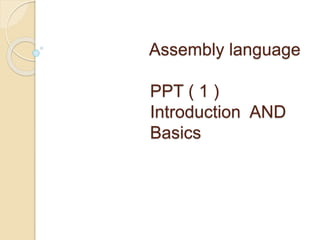
Assembly language
- 1. Assembly language PPT ( 1 ) Introduction AND Basics
- 2. What is assembly language An assembly language is a low-level programming language for microprocessors and other programmable devices. It is the most basic programming language available for any processor. A processor understands only machine language instructions, which are strings of 1's and 0's. However, machine language is too obscure and complex for using in software development , instead low level assembly language is used .
- 4. Compilation flow explained Preprocessing : is the first pass of any C compilation. It processes include-files, conditional compilation instructions and macros. Compilation : is the second pass. It takes the output of the preprocessor, and the source code, and generates assembler source code. Assembly : is the third stage of compilation. It takes the assembly source code and produces an assembly listing with offsets. The assembler output is stored in an object file.
- 5. Linking : is the final stage of compilation. It takes one or more object files or libraries as input and combines them to produce a single (usually executable) file. In doing so, it resolves references to external symbols, assigns final addresses to procedures/functions and variables, and revises code and data to reflect new addresses (a process called relocation).
- 6. Basic feature of PC hardware Motherboard : The motherboard serves to connect all of the parts of a computer together. The cpu, memory, hard drives, optical drives, video card, sound card and other ports and expansion cards all connect to the motherboard directly or via cables.
- 8. BIOS :lowest-level software in the computer, acts as an interface between the hardware and the operating system . ROM : is nonvolatile. ROM chips contain permanently written data, called firmware (your BIOS lives here). RAM : RAM devices are used in computer systems as the main memory. RAM is considered volatile memory, which means that the stored information is lost when there is no power.
- 10. Control unit : A control unit (CU) handles all processor control signals . It directs all input and output flow, fetches code for instructions from microprograms and directs other units and models by providing control and timing signals. ALU : An ALU performs basic arithmetic and logic operations. Examples of arithmetic operations are addition, subtraction, multiplication, and division. Examples of logic operations are comparisons of values such as NOT, AND, and OR. Registers : In a computer, a register is one of a small set of data holding places that are part of a computer processor . A register may hold a computer instruction , a storage address, or any kind of data.
- 11. Bus : The CPU moves data around the computer on pathways that interconnect it to all the other components on the motherboard. These pathways are called 'buses‘ Types of Bus Address - the components pass memory addresses to one another over the address bus. Control - used to send out signals to coordinate and manage the activities of the motherboard components. Data - transferred between peripherals, memory and the CPU. Obviously, the data bus can be a very busy pathway.
- 12. Number system A set of values used to represent different quantities is known as Number System Types of number system 1. Binary - Or base 2. There are only two numbers in binary, 0 and 1. Because computers use a sequence of switches that can be on or off (also called a bit), base 2 works very well for them. Math in base 2 is pathetically simple, but incredibly time consuming 2. Octal - Or base 8. Uses the numbers 0 to 7. There are eight bits in a byte which is used very often in the computer field. (A bit is great, but it's too small to hold any useful data, thus the byte is used.) Math in octal is more complicated than decimal 3. Decimal - Or base 10. Uses the numbers 0-9. I'm sure you're familiar with this system. Computers only display numbers in decimal, they actually do all their work in binary. Math is quite simple with this number system, although some may argue. 4. Hexadecimal - Or base 16. Uses the numbers 0-F. Yes, I said F. Because there are 16 values per place holder, five new numbers had to be created. Those numbers are A, B, C, D, E, and F (Original isn't it?). "A" has a value of 10, "B" is 11, and so on
- 13. NUMBER SYSTEM SYSTEM BASE DIGITS BINARY 2 01 OCTA L 8 01234567 DECIMAL 10 0123456789 HEXADECIMAL 16 0123456789ABCDE F
